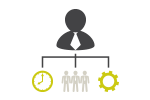Conducive Culture
“Culture eats strategy for breakfast”. Chilling words for any organisation trying to break new ground. But oh so true. You can have the greatest strategy but if the culture of the organisation isn’t conducive, then the blockers turn up thick and fast. So really understanding the constituent parts and what needs to change in each is key.

Values
-
How an organisation collectively behaves is a clear indicator of what it holds dear and values. The question is whether this behaviour is conducive to delivering against its required Purpose, Vision and future strategic direction? The answer is to create a well-defined Value set, and then effectively embed and reinforce it in the organisation so that behaviour is aligned with the required outcome rather than leaving this to chance. At MAX VMG we have a unique and inclusive process to both define the required values and then engage the organisation on what needs to start, continue or stop so that they can live.

Leadership style

-
No-one has more influence on the culture than the Leadership within. Collectively they influence the behaviour of every employee and so have a pivotal role to play. Really understanding the collective styles that are experienced across the organisation is crucial, so that you can understand what’s good about that and what’s not considering the aspired future direction. Once these have been assessed the next stage is to define the required characteristics for the future state which is often represented through a bespoke leadership Model. This serves as the aspiration for all and becomes a mechanism for assessment and development of each individual leader as well as the leadership as a whole.
Talent management
-
Everything done to recruit, retain, develop and reward people forms a part of talent management. The clarity, effectiveness and structure of this is crucial to create an environment that people want to be a part of so that they stay engaged, motivated and growing, and that the path to that is clear. If it’s lacking then people can become disillusioned and demotivated, and either ‘quit and stay’ or leave the organisation for another that offers better opportunities for fulfilment or growth. Understanding the current process for this and what works and what doesn’t is vital so as to establish what shifts need to be made through a talent management development plan formed in conjunction between MAX VMG’s experts and the HR function.

Performance Management

-
It’s a simple fact that what gets measured drives behaviour. The issue is when those measurements are out of kilter with what the organisation wishes to see in terms of behaviour and output for its required future state. So we’re looking to fully understand the metrics and process to ensure they are in alignment, and if not what needs to change. Also how the performance management process is executed is key to its success. Do employees see it as an opportunity to discuss their progress or a threat that fills them with dread? Undoubtedly the former is our goal, which requires the right timing, process, communication and execution from those involved in implementation. Lastly, it’s our belief that performance isn't managed periodically to have the greatest effect. It should be a day to day priority, applauding good performance and correcting underperformance so the formal periodic assessment appraisal holds no surprises.
Structure
-
An organisations’ structure defines how activities such as task allocation, coordination and supervision are directed toward the achievement of organisational goals. Optimising it is key, so that output for the customer is achieved in the most efficient fashion, which is a key enabler of competitive advantage. The process is two part - a diagnostic and design phase drawing on a vertical slice of informed personnel from the organisation combined with referencing the latest theory in organisation design and examining how the strongest competitors in the sector, or those that are deemed ‘world class’ in similar sectors, are organising themselves. Execution of required changes are supported through a thorough implementation plan and engagement workshops to realise the optimum structure for all.

Systems

-
Organisations are supported by a myriad of systems that are there to perform vital control and administration functions. When optimised and ‘in tune’ with an organisations strategic direction, they can be real enablers. But when clunky, outdated or mismatched they can be real inhibitors to progress and the bain of peoples’ lives. So it is important to consider their suitability and health in relation to the forward trajectory of the organisation and what can be done to optimise or replace those that, for whatever reason, aren’t making the grade.
Work groups are then be formed and supported by MAX VMG experts to bring about the changes.
